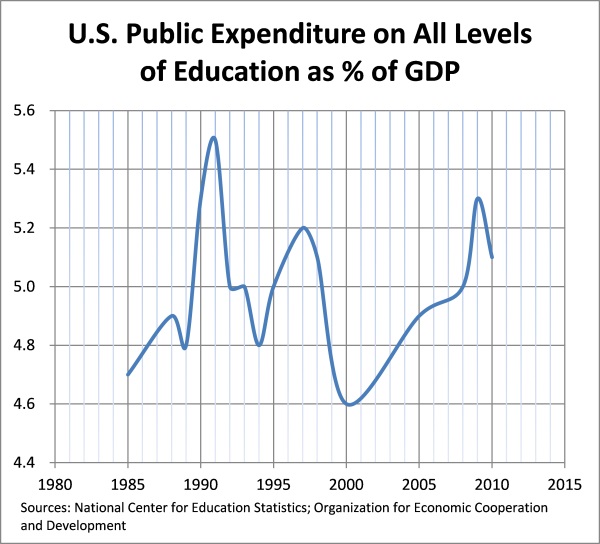President Obama says public investment in schools was “allowed to wither” as a result of the “trickle-down ideology” of recent decades. There’s no clear trend for public spending on education as a percentage of the U.S. economy, but public investment hasn’t withered. It has increased from 4.7 percent in 1985 to 5.1 percent in 2010 with ups and downs along the way.
Obama spoke on economic inequality in a Dec. 4 speech at the Town Hall Education Arts Recreation Campus in Washington, D.C. He said that “starting in the late 70s” the social compact between government and its people “began to unravel.”
Obama, Dec. 4: As values of community broke down, and competitive pressure increased, businesses lobbied Washington to weaken unions and the value of the minimum wage. As a trickle-down ideology became more prominent, taxes were slashed for the wealthiest, while investments in things that make us all richer, like schools and infrastructure, were allowed to wither.
We were curious about his harsh assessment of public investment in educational spending. His reference to tax cuts and a “trickle-down ideology” is no doubt a reference to the tax cuts under Republican administrations, beginning in the 1980s with President Reagan. But has public investment been allowed to wither since then? We asked the White House for evidence, but it provided none.
We also contacted the National Center for Education Statistics, which did respond.
The NCES provided us with various reports that contained expenditure data from the Organisation for Economic Co-operation and Development (OECD), an international organization that promotes the social well-being of people around the world. The OECD regularly produces reports on public spending on education as a percentage of the gross domestic product (GDP) for each member nation, including the United States. That’s the measure we use here, because as the NCES puts it in one of the reports we reviewed: “The percentage of the GDP spent on education from public sources may reflect the value a country places on education, as well as differences in income within a country.”
We reviewed four NCES reports that collectively contained data from 1985 through 2010 for education spending. The specific reports covered 1985 through 1994, 1995, 1997 and 1998, and the most recent one for the years 2000, 2005, and 2008 through 2010. We looked specifically at the data on public spending as a percent of GDP for all education levels, from primary school through higher education institutions. There were no data for some years. In all, there were 16 data points over a 26-year period.
Public spending on education was 4.7 percent of GDP in 1985 and 5.1 percent in 2010. The high during that period was 5.5 percent in 1991 and the low was 4.6 percent in 2000.
There are limitations to the OCED data.
The OECD says it changed its classification system in 1996, so we asked Susan Aud, a senior research scientist at the NCES, how the change affected the percentages. She told us in an email that “the reclassification resulted in percentages that are generally less than a few tenths lower.” For the purposes of fact-checking the president’s statement, that doesn’t affect our analysis since the post-1996 figures may actually be lower than they would have been under the old classification period.
The OECD data, too, only goes back to 1985 and the president referenced tax cuts that began in the early 1980s. The NCES did provide us with a chart showing total expenditures — public and private — as a percent of GDP from 1929 through 2011. It does not separate the public and private investments, but it does show total expenditures tumbling from a high point in the 1970s of 7 percent of GDP in 1975 to a low in the 1980s of 6.1 percent in 1981, 1984 and 1985.
That may provide some evidence of retrenchment under Reagan, who cut the Department of Education budget by 18.6 percent in his first term, from 1981-1985, according to the conservative American Enterprise Institute. But, as the Education Department notes on its website, the federal government’s “share of total education funding in the U.S. is relatively small.” Most of the expense for education is borne at the state and local level. Also, a December 1996 NCES report described the seven-year period that followed, from 1985 through 1991, as “a span marked by intense education reform” in the United States that coincided with increased public funding.
“In each year from 1985 to 1991, public expenditures for all education levels varied between 3.5 and 7 percent of GDP in all OECD countries with available data,” the report said. “Over this period, public expenditures as a percentage of GDP increased in several countries, including Norway, Portugal, Spain, and the United States.”
As we said, 1991 was the high water mark at 5.5 percent of GDP. It dipped below 5 percent after that, but it has been at or above 5 percent for three straight years from 2008 to 2010, including 5.3 percent in 2009.
An argument can be made that the U.S. does not provide enough public funding for education. After all, public expenditure on education as a percentage of the U.S. economy in 2010 was below the OECD average, and ranked the U.S. just 18th out of 29 OECD countries. But the data don’t show a clear trend for public investment in education since the mid-1980s or evidence that it has been allowed to wither.
— Eugene Kiely
